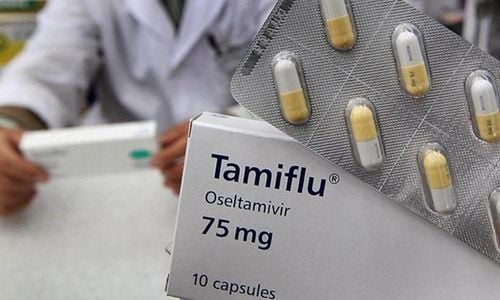This is an automatically translated article.
Tiamenol is a combination pain reliever for the treatment of seasonal allergy symptoms such as runny nose, cough and headache. The drug consists of the main ingredients Paracetamol, Loratadin and Dextromethorphan. Dosage, usage and side effects of Tiamenol will be mentioned in the article below.1. What is Tiamenol?
Tiamenol is classified as an analgesic and anti-allergic drug used in cases of hypersensitivity. Tiamenol is prepared in the form of film-coated tablets, the drug is orange-yellow in color with the packaging of 1 blister of 10 tablets, the box of Tiamenol includes 10 blisters.
Main ingredients and content, in 1 Tiamenol tablet includes:
Paracetamol with a content of 500mg; Loratadine with 5mg strength; Dextromethorphan 15mg and excipients just enough.
2. The effect of the drug Tiamenol
Tiamenol and anti-inflammatory, anti-allergic drugs combined thanks to the composition of both Loratadin, Paracetamol and Dextromethorphan.
With Paracetamol, this is a substance that reduces body temperature in people with fever but does not reduce temperature in normal people. Commonly used in the treatment of mild to moderate pain and fever. Loratadine is a potent, long-acting tricyclic antihistamine with selective peripheral H1-receptor antagonist activity, but no central nervous system calming effect. This substance also works to reduce itching and not hives related to histamine. The Loratadine content in Tiamenol helps patients reduce the symptoms of allergic rhinitis including sneezing, runny nose, itchy nose and itchy eyes.
Dextromethorphan is an active ingredient that works to suppress coughs by inhibiting the cough center located in the medulla oblongata of the patient. Dextromethorphan has the effect of preventing cough symptoms in respiratory tract infections, bronchial irritation and has no expectorant effect.
With the effect of the above 3 active ingredients, Tiamenol is an analgesic and antipyretic combined with the treatment of allergic symptoms such as runny nose, cough, sneezing, runny nose and tears in patients.
3. Indications for taking Tiamenol
Tiamenol is used in the following cases:
Pain relief and fever reduction for patients with colds, body aches with cough, runny nose and chills; Treatment of flu symptoms: Cough, headache, stuffy nose, runny nose, sinusitis, seasonal runny nose and allergic rhinitis.
4. Contraindications to the use of Tiamenol
Tiamenol is contraindicated for the following subjects:
Patients are children under 12 years old; Patients with hypersensitivity to any component of Tiamenol; The patient is a pregnant or lactating mother.
5. Dosage and how to use Tiamenol
Tiamenol is taken orally, the patient should take it with a full glass of water. Dosage in adults and children over 12 years old: Take 1 tablet / time, 2 times a day.
6. Tiamenol drug interactions should be noted
Metoclopramide and Domperidone may increase the rate of absorption of Paracetamol. Cholestyramine reduces the absorption of Paracetamol. Anticoagulants increase the effect of Paracetamol in Tiamenol when used for a long time, increasing the risk of bleeding. With short-term use, there are few side effects. Inhibitors of CY3P4, CYP2D6 increase the concentration of Loratadine and cause side effects. Ketoconazole, Erythromycin and Cimetidine cause increased plasma concentrations of loratadine. Alcohol consumption while taking Tiamenol can increase the sedative effect of Dextromethorphan, causing drowsiness. MAOIs and antidepressants can cause Setoronin syndrome, which causes mental changes, myoclonus, hyperreflexia, sweating, and muscle twitching. CYP2D6 inhibitors (Fluoxetin, Methadone, Paroxetin, Quinidine) increase the plasma concentration of Dextromethorphan, which may lead to insomnia, agitation, respiratory depression or diarrhea. Quinidine alone in high concentrations can increase side effects and disturb the central nervous system.
7. Side effects of Tiamenol
At therapeutic doses, Tiamenol is well tolerated. However, the process of using Tiamenol, patients may still experience side effects such as:
Common:
Skin rash, urticaria, headache, dry mouth, fatigue, dizziness, arrhythmia and nausea. Rare and uncommon:
Anemia, neutropenia, hypovolemia; Renal toxicity with long-term use; Hypersensitivity reactions, dizziness, dry nose, conjunctivitis ; Depression, heart palpitations, chest palpitations, in women may appear irregular menstruation; Decreased liver function, anaphylactic shock; The most severe of the side effects of Tiamenol ever reported were central nervous system depression and respiratory depression. The side effects of Tiamenol are quite diverse, which can be confused with some other pathological symptoms. Therefore, if you experience any of the above effects while taking this medicine, you should stop taking the medicine and notify your doctor.
8. Precautions when using Tiamenol
Tiamenol includes side effects such as drowsiness and headache. Therefore, it is not recommended to use in people who drive and operate machinery. Caution should be exercised when administering Tiamenol to patients with impaired liver or kidney function. Two active ingredients, Paracetamol and Loratadin, in Tiamenol have no effect on pregnancy. However, Dextremethorphan has not been clearly recorded. Therefore, it is necessary to consult a doctor if you want to use Tiamenol for pregnant women. All components of Tiamenol are excreted in breast milk. Therefore, Tiamenol should not be used during lactation. Above is all information about Tiamenol drug, patients need to carefully read the instructions for use, consult a doctor / pharmacist before using. Tiamenol is a prescription drug, and patients should absolutely not self-medicate at home because they may experience unwanted side effects.













